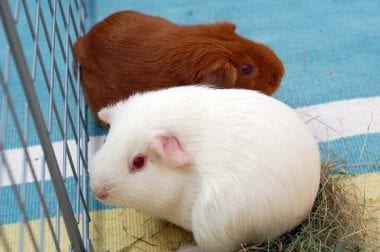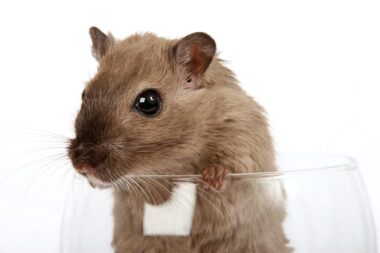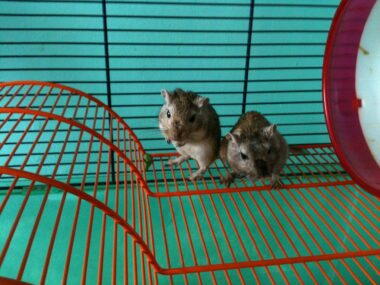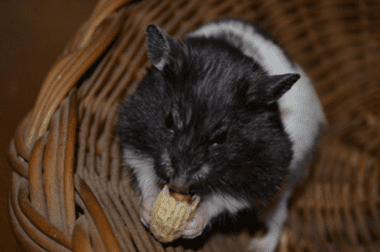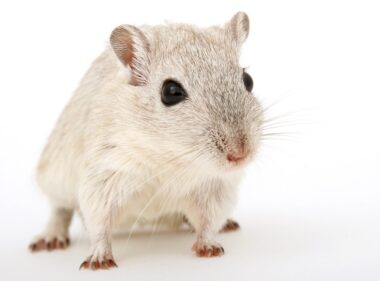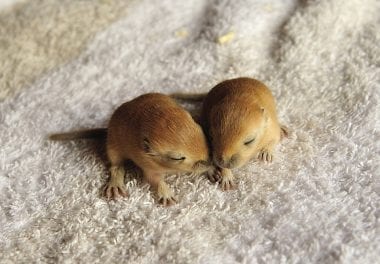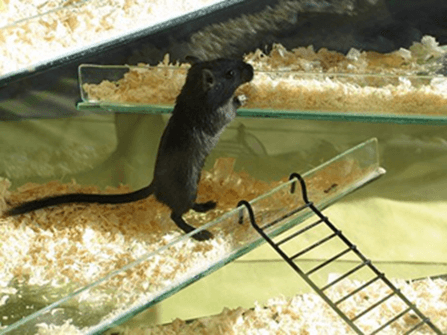
Before setting out to make gerbil cages for your pet, we need to have a clear understanding of their natural habitats. Gerbils are desert dwellers found mostly in the arid wastelands of Asia, Africa, and the Middle East. This means that cold climates don’t suit these ‘desert rats.’
Mongolian gerbils: Besides the vast sandy deserts, they also live in arid steppes having very hot temperatures. They are excellent in burrowing to build complex tunnels.
Fat-tailed gerbils: Their natural habitat is the Sahara desert. They find refuge from the oppressing heat in deep burrows. Their burrows are not as deep and intricate as those of the Mongolian gerbil.
Housing For Captive Gerbils
Due to their similarity with mice and hamsters people mistakenly believe that gerbils too can live in cages designed for the other species of rodents. This is far from the truth. It is ingrained into the nature of gerbils to dig rather than live in ready made tunnels. Digging keeps them active and healthy. The absence of opportunities to dig can leave them depressed. Another factor that makes mice and hamster cages unsuitable for gerbils is their ability to chew. They will gnaw through the plastic cages quite easily. The most commonly used housing for gerbils is aquarium tanks with enough provision for them to dig.
The Best Materials For Gerbil Cages
They have strong teeth and find great pleasure in gnawing and chewing objects. This is the main reason plastic cages used to house hamsters and mice don’t suit gerbils. Not only will they chew through the material, but ingesting plastic can cause serious health issues to these cute pets. It is best to use hardwood or steel components for their cages.
The Problem With Metal Bars
It is pretty much common to keep mice and hamsters in cages with bars to allow good ventilation. Gerbils will chew on the metal bars which can result in grave injury to their teeth and also cause the fur near the nose to wear off. The gnawing sound on metal is very irritating for the humans in the house.
Gerbil owners take care of the issue by keeping them in gerbil cages with solid walls. This reduces their chewing sounds drastically from being heard outside. Unlike bars, walls prevent loose diggings from getting kicked all around the cage.
The Three Common Options For Gerbil Cages
Gerbil owners use three kinds of cages irrespective of the advantages and disadvantages of each type.
i. Terrariums.
ii. Plastic nests.
iii. Wire cages.
Clever fittings and designs are used by experienced pet owners to get rid of the disadvantages of each option to keep the gerbils comfortable while the cages last longer.
Let us have a look at the designs of gerbil cages made of each material. Whatever may be the material used to build their living quarters, it should have the below amenities:
i. Non-plastic Toys: Each pet needs toys that shall cater to their instincts. I the case of gerbils, it should be toys meant for chewing and gnawing. Having enough toys to chew on will make them chew less on their cages. This will ensure that the cages will last longer. A common apparatus is a wooden piece having holes big enough the let the rodents slip inside. Cardboard boxes and rolls of toilet paper are sources to keep the gerbils occupied with their chewing.
ii. Exercise Wheel: A wire mesh wheel about 8 or 9 inches will be great for the gerbils to exhaust their energy which otherwise would have gone into chewing on their cages. Be warned that a slat-style wheel will cause harm to their tails. The best materials to keep the wheels oiled are beeswax or lip balm.
iii. Water Bottle: fasten a water bottle that will hold about 6 – 8 ounces of water. Thirsty gerbils are prone to more chewing that will cause damage to their nests. Maintain adequate water level in the container and clean it at least once a week to get rid of any fungi or bacterial formations.
iv. A Wooden Bird Nest Box: Keep one or two nest boxes inside the gerbil cages to keep the inhabitants content. They will use the boxes as a hideout or sleep. A restless gerbil will be all the happier to gnaw on their cages which will reduce the cage’s life.
Importance of Altitude
The measurements of the housing facility play a great role in adding to their longevity. Unlike mice and hamsters, gerbils are highly active and love climbing. A pair of these rodents need about 90 cm long floor space. They will dig down and climb, so both these matters should be considered in constructing gerbil cages that shall last longer.
Including height and apparatus for climbing and playing keeps your hyperactive pets engaged. Now we have to think about their digging instincts. Make their houses in such a way that the design allows at least a foot of digging material. These provisions will keep the gerbils engaged and happy while desisting them from chewing on the walls or bars of their cages.
Clever Improvisations
Certain well-thought-out ideas from experienced gerbil owners will drastically make the cages last long.
i. Platforms at different levels: Small platforms at different height levels will give additional activity for the gerbils to keep them curious and engaged.
ii. Sand baths: Allowing the gerbils to play for about an hour in dirt-free chinchilla dust helps to reduce oil content from their coat. Skin irritation is a thing that irritates gerbils and causes them to chew on cage fixtures.

Aquarium Housings
Gerbils cannot gnaw on glass, so an aquarium is a great gerbil cage that will last much longer than cages made from other materials. Gerbils cannot kick around the bedding outside the glass enclosure, unlike wire mesh cages. This feature keeps the surrounding areas clean. To maintain good ventilation, it is necessary to have a meshed roof.
Natural File For Claws
Gerbils have long and strong claws that can scratch many surfaces. Placing a hard brick or a stone inadvertently inside the gerbil cages will act as natural trimmers. It will prevent claw marks and grooves on the cage. Another advantage is that you will be spared from the task of filing their claws.
Size Matters
The size of the gerbil cages plays a considerable role in long-lasting homes. If they have ample space to engage in activities, they will not remain confined to a small space in comparison to their body sizes. Confinement will induce them to chew on the nearest available material, which can be the cage wall. A spatial cage should have the below space allowances:
i. Volume: 20 gallons.
ii. Area: 2500 cm2.
iii. Height: 30 cm.
These measurements are for pair as gerbils are social animals that love company.
Ease Of Cleaning
The enclosures should be fashioned in such a way that it should contain the gerbils while letting you remove it easily for a thorough cleaning. Cleaning the cages is a good measure to remove smudges and also to discover any damages to repair them n time. Gerbil cages that are cleaned properly will last longer.
Placement Of The Cages
The location of gerbil cages plays a great role in improving their lives. The below factors are taken into account while choosing a suitable location for the cages:
i. Temperature: The natural habitats of gerbils are very hot, so it is not wise to keep them in room temperatures that are too cold. The ideal temperature for keeping gerbils is 68°F to 75°F. Normal rooms usually maintain this temperature range. If you are compelled to place the cage in an attic or basement, make provisions for temperature control.
Temperature variations will make the gerbils want to gnaw off causing damages to their cages.
ii. Direct Sunlight: Gerbils are active during the night as well as day, so they are crepuscular pets. Their activity increases during the dawn and dusk. Their sleeping and waking habits depend on the lighting pattern available at the place where the cages sit. A gerbil with ‘jet lag’ is a very angry animal that will chew into anything. Place the cage in a spot that will allow them a natural light cycle. This will elongate the longevity of the cages.
The Exact Location Of The Cage
It is not sufficient to select a suitable room for the cage. The way you place it in the chosen location is very important.
i. Accessibility of predators: Gerbils are afraid of common house pets like cats or dogs. Even if a pet doesn’t cause harm, the very sight and smell can stress them out. A stressed-out gerbil can damage its cage.
ii. Cold and hot sources: Direct exposure to artificial or natural sources of either heat or cold does not go well with gerbils. Place the cage in such a way that temperature sources have no direct access.
iii. The Height Level: Gerbils’ natural instincts force them to hide from predators. As a pet owner, if the gerbil feels that you are proceeding towards them from too high a position, their instincts to hide from a bird of prey will jump in. They can bite you or run off to gnaw on the surfaces of their cages. This situation can be voided by placing the cage at the same level or a bit above.
In short, keep your gerbils comfortable and happy in suitable conditions to make their cages last longer.

